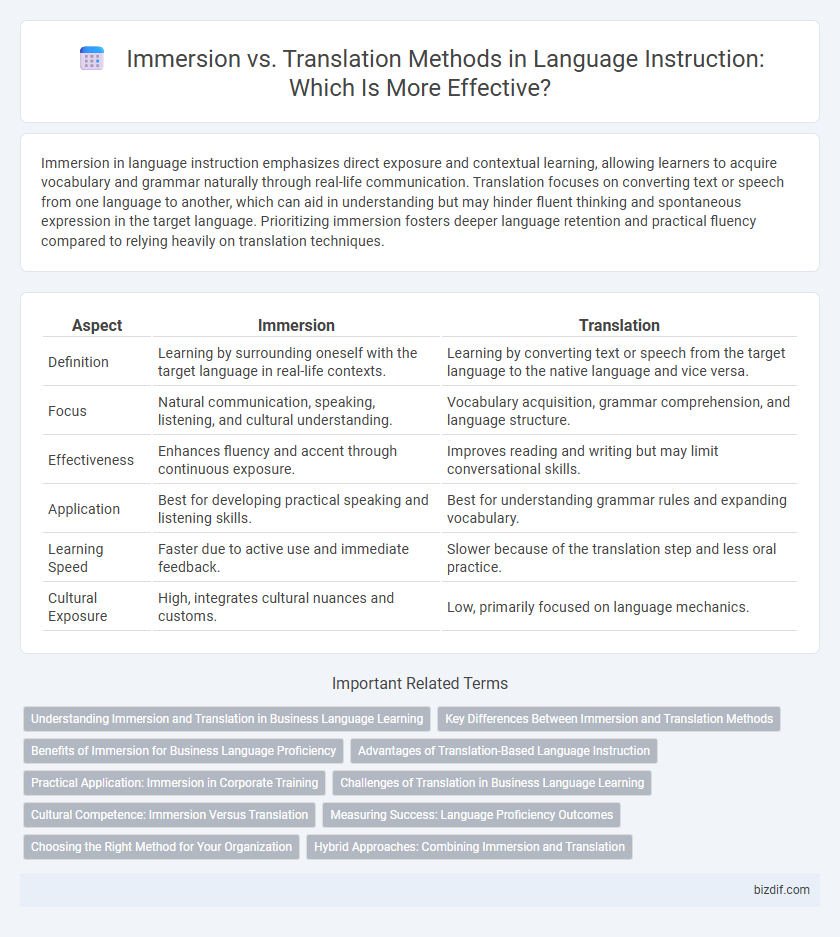Immersion in language instruction emphasizes direct exposure and contextual learning, allowing learners to acquire vocabulary and grammar naturally through real-life communication. Translation focuses on converting text or speech from one language to another, which can aid in understanding but may hinder fluent thinking and spontaneous expression in the target language. Prioritizing immersion fosters deeper language retention and practical fluency compared to relying heavily on translation techniques.
Table of Comparison
| Aspect | Immersion | Translation |
|---|---|---|
| Definition | Learning by surrounding oneself with the target language in real-life contexts. | Learning by converting text or speech from the target language to the native language and vice versa. |
| Focus | Natural communication, speaking, listening, and cultural understanding. | Vocabulary acquisition, grammar comprehension, and language structure. |
| Effectiveness | Enhances fluency and accent through continuous exposure. | Improves reading and writing but may limit conversational skills. |
| Application | Best for developing practical speaking and listening skills. | Best for understanding grammar rules and expanding vocabulary. |
| Learning Speed | Faster due to active use and immediate feedback. | Slower because of the translation step and less oral practice. |
| Cultural Exposure | High, integrates cultural nuances and customs. | Low, primarily focused on language mechanics. |
Understanding Immersion and Translation in Business Language Learning
Immersion in business language learning involves surrounding learners with authentic linguistic environments, enabling natural acquisition of vocabulary and professional communication skills through real-world practice. Translation focuses on converting business texts between languages, enhancing understanding of terminology, syntax, and cultural nuances critical for accurate and effective communication. Balancing immersion and translation methods supports comprehensive language proficiency, fostering both practical usage and detailed comprehension in corporate settings.
Key Differences Between Immersion and Translation Methods
Immersion language instruction emphasizes learning through direct interaction and communication in the target language, promoting natural acquisition and fluency, while translation methods rely on converting text from one language to another, focusing on vocabulary and grammar comprehension. Immersion fosters cultural understanding and practical usage, whereas translation develops analytical skills and explicit language knowledge. These key differences highlight immersion's advantage in contextual learning and translation's strength in detailed linguistic analysis.
Benefits of Immersion for Business Language Proficiency
Immersion accelerates business language proficiency by exposing learners to authentic vocabulary, cultural nuances, and real-time communication scenarios essential for effective negotiations and networking. This method enhances listening and speaking skills more naturally compared to translation-based approaches, enabling professionals to respond swiftly and confidently in diverse business contexts. Immersion also fosters deeper cultural understanding, crucial for building trust and successful international partnerships.
Advantages of Translation-Based Language Instruction
Translation-based language instruction enhances vocabulary retention by providing clear semantic connections between native and target languages. It facilitates deeper grammatical understanding through direct comparison, helping learners grasp syntactic structures more effectively. This method also supports cognitive development by engaging analytical skills and promoting metalinguistic awareness.
Practical Application: Immersion in Corporate Training
Immersion in corporate training accelerates language acquisition by placing employees in real-world scenarios where they actively use the target language, enhancing contextual understanding and retention. Unlike translation-based methods, immersion fosters direct communication skills and cultural fluency essential for effective global business interactions. This approach significantly improves problem-solving abilities and adaptability in multilingual corporate environments.
Challenges of Translation in Business Language Learning
Translation in business language learning presents challenges such as capturing industry-specific terminology and cultural nuances accurately, which can affect communication clarity and professional credibility. Literal translation may lead to misunderstandings or loss of intended meaning, particularly in negotiating contracts or marketing materials. Mastery of context-driven translation techniques is essential to ensure effective and precise business communication across languages.
Cultural Competence: Immersion Versus Translation
Immersion cultivates cultural competence by exposing learners to authentic language usage, social customs, and contextual nuances inherent in the target culture. Translation emphasizes linguistic equivalence but often overlooks cultural subtleties, limiting deeper intercultural understanding. Effective language instruction integrates immersion techniques to develop practical cultural awareness alongside linguistic skills.
Measuring Success: Language Proficiency Outcomes
Measuring success in language instruction through immersion often reveals higher proficiency in speaking and listening skills due to contextual learning and real-time practice. Translation-based methods typically enhance reading and writing abilities by focusing on vocabulary and grammar accuracy. Comparative studies show immersion learners outperform in conversational fluency, while translation learners excel in literary comprehension and formal language use.
Choosing the Right Method for Your Organization
Selecting the appropriate language instruction method depends on the organization's goals, learner proficiency, and resource availability. Immersion fosters natural language acquisition through real-life context and cultural exposure, enhancing fluency and retention. Translation-based instruction benefits learners by developing analytical skills and understanding of linguistic structures, making it suitable for environments prioritizing accuracy and explicit grammar comprehension.
Hybrid Approaches: Combining Immersion and Translation
Hybrid language instruction combines immersion techniques with translation to enhance comprehension and retention. This approach uses immersive environments to develop natural language skills while incorporating targeted translation exercises to clarify complex vocabulary and grammar. Research shows that blending immersion with translation accelerates fluency and deepens cultural understanding.
Immersion vs Translation Infographic

 bizdif.com
bizdif.com